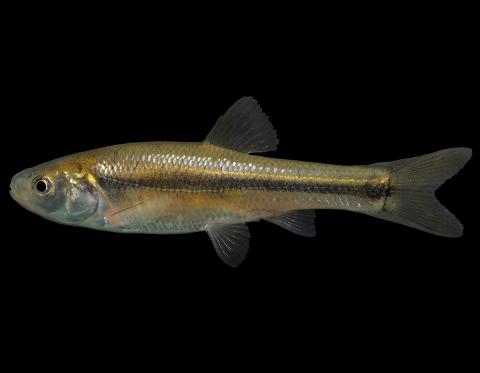Fathead minnows are often stocked in new ponds and lakes as a forage fish. If this is done before stocking the impoundment with a typical bass- bluegill-channel catfish combination an immediate nutrient base for the sport fish population is ensured. Although the bass-bluegill-channel catfish combination will usually do well on its own, minnow stocking helps ensure that the fish population gets off to a good start. It will provide the newly introduced bass with a food source as soon as they are large enough to capture it.
The fathead minnow is principally a river species, common to the Prairie Region of Missouri. Its diet consists mainly of algae and other plant material, but it also consumes aquatic insects. Fathead minnows are easy to propagate and are hardy in a bait bucket, making them one of the most commonly used bait minnows in North America.
Many anglers call these minnows blackhead minnows, because during the spawning season breeding males assume a very dark color about the head and may have dark vertical bands on the body. The males also develop pointed knobs on their snouts and chins called tubercles. These are used both to bump unwelcome visitors from their territory and to clean the surface of the nest. Fathead minnows make ideal forage fish, because even adult fish are small enough (adults reach only 1.5–3.5 inches) to be eaten by juvenile predator fish.
Fathead minnows should be stocked at a rate of 300 to 500 minnows per surface acre. Hauling and handling instructions can be obtained from vendors of the fish. To maximize their value as forage in new ponds and lakes, fatheads should be stocked as soon as there is sufficient water, and at least one growing season (May– Sept.) before bass are introduced. This gives the minnows a chance to reproduce before the introduction of their main predator.
A good scenario would be to stock fatheads sometime during the spring or summer of the year you stock your bluegill and catfish. Although this stocking sequence offers the best results, some benefit can be achieved by stocking the minnows anytime before or even simultaneously with the bass fingerlings.
Stocking minnows in ponds that already contain established fish populations is not generally recommended as an answer to a slow-growing fish population. The minnows would likely be eaten by resident fish immediately after stocking, and thus would serve only as short-lived, expensive fish food.
In Missouri, spawning usually occurs from the second week in May to early August. If fathead minnows are stocked before other fish are introduced, their spawning success depends on three factors:
- The availability of appropriate spawning habitat.
- The timing of the stocking.
- The ratio of males to females.
Fathead minnow males prepare a nest site by cleaning the undersurface of rocks, twigs, and boards or tile. These submerged objects are where female fatheads will deposit their eggs. Males remain with the eggs until they hatch.
If you wish, you can improve spawning success by providing the minnows with good nesting habitat, such as cedar shingles. These shingles should be driven into the pond bank at intervals of approximately 2 to 3 feet and should be installed no deeper than 1.5 feet beneath the water’s surface at a 45 degree angle in relation to the pond’s bottom.
To achieve a suitable ratio of males to females, make sure that the minnows stocked vary in size. Fathead males are larger than females, so stocking mostly large minnows could result in poor spawning success.
Mortality of fathead minnows is high and the maximum life span for the species is approximately three summers. However, when predatory fish such as bluegill and largemouth bass are stocked their lifespan can be much less.
Sources
You can often buy fathead minnows through local feed and grain stores, or through bait suppliers. Commercial sources of fish are available throughout Missouri. Please contact your nearest Conservation Department office for a list of commercial fish producers, and for more information concerning pond management.






















